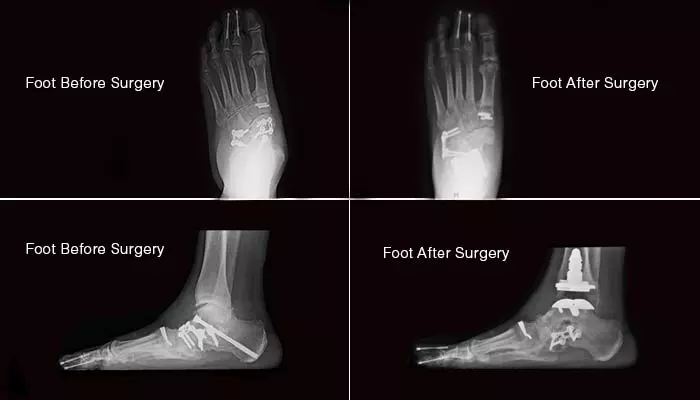- Home
- Patient Stories
- Complex Foot Deformity and Ankle Replacement - Dan Sullivan
Complex Foot Deformity and Ankle Replacement - Daniel Sullivan, DDS
 Daniel Sullivan, DDS, says he had a complex puzzle to solve. A practicing dentist in University City, MO for more than 30 years before retiring, Sullivan had spent his entire life with a bowed leg, which progressively aggravated both his left knee and foot.
Daniel Sullivan, DDS, says he had a complex puzzle to solve. A practicing dentist in University City, MO for more than 30 years before retiring, Sullivan had spent his entire life with a bowed leg, which progressively aggravated both his left knee and foot.
“I had flat feet and even after I had a knee replacement, the left foot gradually got worse and worse, with my toes crossing over each other,” Sullivan said. “I couldn’t bear my own weight very well at all.”
Thinking there must be an easy solution, Sullivan first opted for a procedure that uncrossed and fused his toe bones. “As I found out later, that may have fixed the crossed toes, but nothing else inside the foot was corrected,” he said.
With growing pain, he consented to a second procedure that resulted in pins and metal plates being placed inside his foot to stabilize his bones. Three months later, though, Sullivan felt something break inside. “My foot started clicking and hurting and gradually the foot started turning out sideways,” he recalled. “My ankle was so swollen I couldn’t wear normal shoes. That’s when I sought out a second opinion.”
His search led him to Jeffrey Johnson, MD, a foot and ankle surgeon in the Department of Orthopedic Surgery at Washington University School of Medicine. Johnson has a national reputation as a specialist in complex foot deformities and is known for his thoughtful approach to multi-stage surgical procedures.
“Mr. Sullivan’s foot and ankle problems were incredibly complex and complicated by the fact that he had two prior failed procedures and he had developed both deformity and arthritis in his ankle as well as the foot,” said Johnson. “What had happened over time was that he had a progressive collapse of the arch of the foot and a deformity in the back of the foot that caused the heel to tip outward. Once the foot collapses and the heel turns out, that puts additional stress on the ankle because the foot is no longer aligned correctly.”
“It was really a mess,” admitted Sullivan. “Everything was out of alignment. He told me I had torn tendons and ligaments and dislocated minor joints in my foot. The poor foot alignment also wore away some of my anklebone, so I needed an ankle replacement. I was very nervous about it all, but Dr. Johnson does everything so thoughtfully and carefully that I knew I was in good hands.”
Step one required Johnson to remove previous metal plates and screws and then re-build and re-align Sullivan’s foot. Johnson also tightened or shortened some ligaments that had stretched out due to the poor alignment. To repair the places where Sullivan’s anklebone had worn away, Johnson injected a special cement-like glue to support the bone temporarily while the foot healed.

Five months later, Johnson performed a second surgical procedure that implanted a new ankle joint and further corrected stretched tendons and ligaments to restore overall ankle stability. It required extensive pre-surgical mapping of the location of specific deformities as well as custom surgical guides.

For these types of multi-stage procedures, Johnson tells his patients that it could take up to a year for a full recovery. The key to a successful outcome, he stresses, is for patients to consistently keep up with a home exercise and rehabilitation plan.
Sullivan, who couldn’t bear weight on his left leg at all prior to Johnson’s first procedure, now is walking and riding a bicycle. He says scuba diving and hiking trips also are being planned. “I took a trip to London recently and was able to walk around the various gardens and museums with no pain,” he said. “My wife and I love to travel. Now that my foot and ankle are better, I can do all of those things again.”
He added, “I’m grateful to Dr. Johnson for being so thorough in both his evaluation and his approach to my problems. I tried to seek out a simpler solution but it didn’t work. I had to find the right solution and the right doctor.”
Dr. Johnson retired from Washington University Orthopedics in the fall of 2020. If you have a foot or ankle concern, please contact our board-certified, fellowship-trained foot and ankle specialists at 314-514-3500.
More Info: